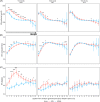Epidermal renewal during the treatment of atopic dermatitis lesions: A study coupling line-field confocal optical coherence tomography with artificial intelligence quantifications: LC-OCT reveals new biological markers of AD
- PMID: 39305199
- PMCID: PMC11415820
- DOI: 10.1111/srt.13891
Epidermal renewal during the treatment of atopic dermatitis lesions: A study coupling line-field confocal optical coherence tomography with artificial intelligence quantifications: LC-OCT reveals new biological markers of AD
Abstract
Objective: This study explores the application of Line-field Confocal Optical Coherence Tomography (LC-OCT) imaging coupled with artificial intelligence (AI)-based algorithms to investigate atopic dermatitis (AD), a common inflammatory dermatosis.
Materials and methods: AD acute and chronic lesions (ADL) were compared to clinically healthy-looking skin (ADNL). LC-OCT was used noninvasively and in real-time to image the skin of AD patients during flare-ups and monitor remissions under topical steroid treatment for 2 weeks. Quantitative parameters were extracted from the images, including morphological and cellular-level markers of epidermal architecture. A novel cellular-level parameter, nuclei "atypia," which quantifies the orderliness of epidermal renewal, was used to highlight abnormal maturation processes.
Results: Compared to healthy skin, AD lesions exhibited significant increases in both epidermal and stratum corneum (SC) thickness, along with a more undulated dermo-epidermal junction (DEJ). Additionally, keratinocyte nuclei (KN) were larger, less compact, and less organized in lesional areas, as indicated by the atypia parameter. A higher degree of atypia was observed in chronic lesions compared to acute ones. Following treatment, all the parameters normalized to levels observed in healthy skin within 2 weeks, mirroring clinical improvements.
Conclusion: This study provides insights into the quantification of epidermal renewal using a noninvasive imaging technique, highlighting differences between ADL/ADNL and acute/chronic lesions. It also presents the AD treatment mechanism, paving the way for future investigations on AD and other skin barrier function-related conditions.
Keywords: LC‐OCT; artificial intelligence; atopic dermatitis; biomarkers; corticosteroids; epidermis.
© 2024 The Author(s). Skin Research and Technology published by John Wiley & Sons Ltd.
Conflict of interest statement
H.L.B., E.R., S.B., G.R., and B.L. are employees at L'Oréal. E.R. and A.S. are dermatologist consultants for L'Oréal Advanced Research in BRC, St Louis Hospital. J‐D.B. received research grants for L'Oréal. M.J. does not possess any conflict of interest.
Figures




References
-
- International Eczema Council . Global Report on Atopic Dermatitis. GADA. 2022. https://www.eczemacouncil.org/assets/docs/global‐report‐on‐atopic‐dermat...
-
- Lee JT, Cho YS, Son JY. Relationship between ambient ozone concentrations and daily hospital admissions for childhood asthma/atopic dermatitis in two cities of Korea during 2004–2005. Int J Environ Health Res. 2010;20:1–11. - PubMed
-
- Kodama A, Horikawa T, Suzuki T, et al. Effect of stress on atopic dermatitis: investigation in patients after the Great Hanshin earthquake. J Allergy Clin Immunol. 1999;104:173–176. - PubMed
MeSH terms
Substances
Grants and funding
LinkOut - more resources
Full Text Sources

